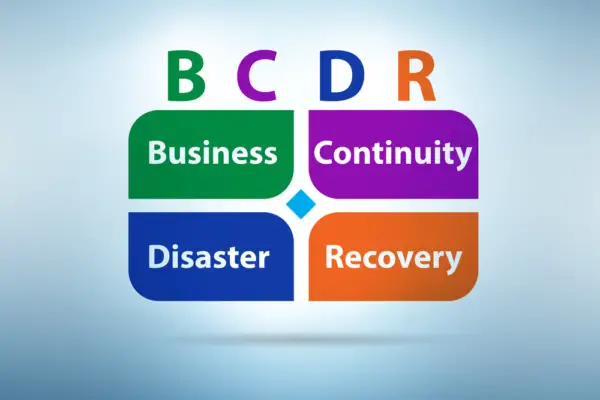A Business Continuity Plan (BCP) is a comprehensive, proactive plan that outlines the procedures and instructions an organization must follow in the face of a disaster or disruption to maintain business operations.
It’s a critical component of an organization’s risk management strategy and ensures that personnel and assets are protected and able to function during and after a significant disruptive event.
The goal of a BCP is to minimize the negative impact of disruptions on business operations and to ensure the organization can continue to function or quickly resume critical activities. A BCP typically includes:
- Identification of essential business functions and processes.
- Risk assessments and business impact analyses to determine which business functions are critical and the potential impact of disruptions.
- Strategies and procedures for maintaining and restoring business operations, which may include alternative work arrangements, such as remote work or relocating to an alternate site.
- Communication plans for keeping employees, customers, suppliers, and other stakeholders informed during and after a disruption.
- Roles and responsibilities for the business continuity team and other key personnel during a disruption.
- Procedures for training and testing the plan to ensure its effectiveness and that staff are familiar with their roles in an emergency.
A BCP is a dynamic document that needs regular reviews and updates to reflect changes in the business environment, technology, and organizational structure. (Investopedia)
In today’s complex and ever-evolving business landscape, the concept of a business continuation plan, more commonly referred to as a business continuity plan (BCP), is an indispensable strategic tool that ensures a company’s resilience and steadfast operation in the face of disruptions.
A BCP is a comprehensive, proactive blueprint designed to maintain business functions or quickly resume them in the event of a major disruption, whether due to natural disasters, cyber-attacks, or any other unforeseen emergencies.
The meticulous crafting of such a plan requires an in-depth analysis of organizational workflows, critical functions, and the dependencies between various business areas.

As we delve into the intricate layers of business continuity planning, one must ponder the fundamental components that construct an effective BCP and its critical role in safeguarding an organization’s assets, reputation, and future viability.
The question beckons: how does a robust business continuation plan offer a lifeline in turbulent times, and what strategic steps must businesses undertake to shield themselves from the potential chaos of unanticipated events?
Key Takeaways
- Business Continuity Planning (BCP) ensures the maintenance of business operations during disruptions.
- A robust business continuity plan minimizes operational downtime and protects essential functions.
- Business Continuity Planning involves prevention and recovery systems, protecting personnel and assets.
- Risk assessment, business impact analysis, recovery prioritization, and strategies for risk mitigation are key components of a business continuity plan.
Definition of a business continuation plan
A Business Continuation Plan is a strategic framework designed to enable an organization to maintain or quickly resume critical functions following a disruptive event.
Often termed a business continuity plan, this document stems from a thorough business continuity planning process, which includes a business impact analysis to identify the critical business functions most at risk.
In the event of a business disruption, whether from natural disasters or other emergencies, the continuation plan outlines essential recovery strategies, ensuring the least possible impact on business operations.
Integral to business continuity management, the plan works in tandem with a disaster recovery plan to provide a comprehensive approach to emergency management, safeguarding the organization’s resilience in the face of unforeseen challenges.
Importance of having a business continuation plan
Understanding the importance of a business continuation plan is crucial, as it serves as an organization’s blueprint for survival in the face of potential disruptions. Here’s why a robust business continuity plan is indispensable:
- Minimizes Downtime: By setting a clear recovery time objective, businesses ensure that critical functions are restored swiftly, minimizing operational downtime.
- Protects Essential Functions: The business continuity planning process identifies essential functions, safeguarding them against unexpected events through proactive disaster recovery planning.
- Enhances Business Resilience: A successful business continuity plan is integral to a business continuity program, fostering resilience and the capacity to adapt and continue operations under adverse conditions.
Educational and engaging, emphasizing these points underscores the strategic advantage of preparedness and the ability to maintain continuity amidst challenges.
Understanding Business Continuity Planning
Understanding Business Continuity Planning is essential for safeguarding the resilience of any organization.
It involves creating systems of prevention and recovery to deal with potential threats to a company.
This strategic approach ensures that personnel and assets are protected and able to function quickly in the event of a disaster.
What is Business Continuity Planning?
Business Continuity Planning (BCP) is a strategic process designed to ensure that companies can maintain essential functions during and after a disaster or significant disruption. It involves:
- Creating a robust business continuity plan template that outlines the steps to take before, during, and after an incident.
- Developing a business continuity strategy that identifies critical operations and processes for swift recovery.
- Engaging business continuity professionals to test and update the plan regularly.
A BCP is not merely a document; it’s an ongoing program that integrates risk management strategy and emergency response with proactive business continuity activities.
From simulating disaster scenarios to refining the recovery plan and incident response plan, it’s about preparing organizations to respond effectively to unforeseen challenges and minimize downtime.
Definition and purpose of business continuity planning
A business continuity plan (BCP) serves as a critical roadmap for organizations, outlining procedures and instructions an organization must follow in the face of disaster, ensuring the maintenance of business operations and minimizing disruption.
Business continuity planning positions a company to recover from interruptions, preserving essential business processes quickly. It involves identifying key business assets and establishing recovery point objectives to maintain functions deemed critical.
When disruptive events occur, the business continuity team, acting akin to emergency responders for the organization, implements the plan, coordinating efforts to restore normalcy.
Moreover, strategies like key person insurance can safeguard against the loss of individuals vital to business functions.
This proactive approach is integral to a robust business continuation plan, protecting stakeholders’ interests and the company’s market position.

Key components of a business continuity plan
At the core of a robust business continuity plan lie several pivotal elements, each designed to ensure an organization’s resilience in the face of disruptions.
These components range from risk assessment and management strategies to recovery procedures that are critical for maintaining operational integrity.
We will now explore the structure and function of these integral parts to appreciate how they interlock to form a comprehensive contingency framework.
Overview of the steps involved in creating a business continuity plan
Creating a robust business continuity plan is a multi-step process that begins with a thorough risk assessment and business impact analysis to identify potential threats and their effects on operations.
The next step involves formulating tailored strategies for risk mitigation and ensuring rapid recovery to maintain business functions during disruptions.
Risk assessment and business impact analysis
Understanding the potential threats and their consequential impacts is a cornerstone of formulating an effective business continuity plan.
Key steps include:
- Risk Assessment: Identifying potential risks and scenarios that can lead to disruptions.
- Business Continuity Impact Analysis: Evaluating the effects on mission-critical functions and critical systems.
- Recovery Prioritization: Making informed decisions about recovery priorities to mitigate business risk and prevent disruption of business functions.
Developing strategies for risk mitigation and recovery
Once potential risks are identified and their impacts analyzed, the next critical step in a business continuity plan is developing robust risk mitigation and recovery strategies.
Crafting an emergency management plan, ensuring business continuity insurance, and bolstering business resiliency are vital.
Address potential incidents like supply chain failure with a clear action plan, ensuring your business continuation plan protects against unforeseen disruptions.
Testing, training, and maintaining the plan
To ensure a business continuity plan remains effective and actionable, regular testing, comprehensive training of personnel, and diligent maintenance are essential components that must be methodically implemented.
- Emergency Simulation: Conduct an annual schedule of drills to identify key differences between the backup plan and action during a real crisis.
- Detailed Strategies: Training programs tailored to educate staff on their specific roles within the continuity framework.
- Maintaining: Regularly update the plan to align with evolving business needs and environments.
Key Terminologies in Business Continuity Planning
Understanding the key terminologies in business continuity planning is crucial for developing an effective strategy to navigate disruptions.
Two critical metrics, Recovery Time Objective (RTO) and Recovery Point Objective (RPO), serve as benchmarks for restoring operations and data after an incident.
These terms not only guide the prioritization of recovery efforts but also help set clear expectations for stakeholders during a crisis.
Recovery Time Objective (RTO)
How quickly can a business resume its critical functions after a disruptive event? This crucial timeframe is defined by the Recovery Time Objective (RTO), a fundamental component of any business continuation plan.
RTO is the target duration within which business processes must be restored to avoid unacceptable consequences due to a break in business continuity.
To understand the importance of RTO, consider the following:
- Business Resilience: Establishing an RTO prompts organizations to enhance their ability to bounce back from interruptions.
- Backup Strategies: RTO influences the design and implementation of backup systems, particularly in cloud environments, to ensure rapid recovery.
- Business Continuity Analysis: Regular analysis of RTO helps maintain alignment with operational functions and essential services, minimizing business disruption.
An effective RTO is not just a number; it’s a commitment to business resilience and continuity.

Recovery Point Objective (RPO)
Parallel to establishing a robust Recovery Time Objective, defining a Recovery Point Objective (RPO) is essential as it determines the maximum tolerable period in which data might be lost due to a major incident.
RPO is critical for disaster recovery and is a cornerstone of a business continuity plan. It helps in assessing the potential hazards that could affect systems and the cloud infrastructure.
Moreover, it guides service providers in designing solutions that minimize data loss.
| Key Component | Description |
|---|---|
| RPO Value | The threshold of data loss measured in time. |
| Impact | Signifies how much data loss a business can withstand. |
| Systems | Identifies which systems need frequent backups. |
| Service Providers | Must ensure RPO targets meet business requirements. |
Business continuation insurance may leverage the RPO to ascertain the resilience vs business continuity strategy, ultimately ensuring critical business functions’ long-term protection and recovery.
Conclusion
Business continuation plan, an integral part of business continuity planning, is pivotal for ensuring organizational resilience in the face of disruptions.
Organizations can develop robust strategies to sustain critical operations by identifying key components and employing pertinent terminologies.
The systematic approach provided by such plans is indispensable for mitigating risks and maintaining continuity, safeguarding stakeholders’ interests and preserving the enterprise’s market position.

Chris Ekai is a Risk Management expert with over 10 years of experience in the field. He has a Master’s(MSc) degree in Risk Management from University of Portsmouth and is a CPA and Finance professional. He currently works as a Content Manager at Risk Publishing, writing about Enterprise Risk Management, Business Continuity Management and Project Management.


